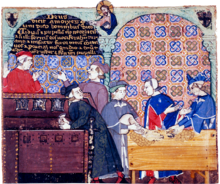


Acounting house, or counting room, was traditionally an office in which the financial books of a business were kept.[1] It was also the place that the business received appointments and correspondence relating to demands for payment.[2]
Originating in Italy, the counting house was a central feature of commerce in the high Middle Ages and afterward. Calculations were typically quantified through the use of a counting board where the process could be spectated by interested persons.[3] As technology developed and new practices emerged, particularly the adoption of Arabic numerals in financial record-keeping, use of the counting board became obsolete.
As the use of counting houses spread in the 19th century, so did their reputation as being often uncomfortable and dreary places to work.[4] This was most famously exemplified in Charles Dickens A Christmas Carol, where the underpaid Bob Cratchit spends his days toiling.
This accounting-related article is a stub. You can help Wikipedia by expanding it. |